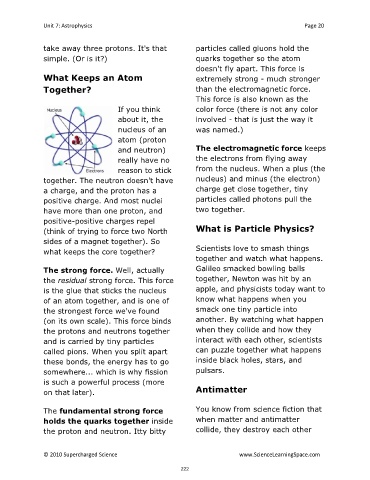Page 222 - Microsoft Word - LessonPlan-Overview.doc
P. 222
Unit 7: Astrophysics Page 20
take away three protons. It's that particles called gluons hold the
simple. (Or is it?) quarks together so the atom
doesn't fly apart. This force is
What Keeps an Atom extremely strong - much stronger
Together? than the electromagnetic force.
This force is also known as the
If you think color force (there is not any color
about it, the involved - that is just the way it
nucleus of an was named.)
atom (proton
and neutron) The electromagnetic force keeps
really have no the electrons from flying away
reason to stick from the nucleus. When a plus (the
together. The neutron doesn't have nucleus) and minus (the electron)
a charge, and the proton has a charge get close together, tiny
positive charge. And most nuclei particles called photons pull the
have more than one proton, and two together.
positive-positive charges repel
(think of trying to force two North What is Particle Physics?
sides of a magnet together). So
Scientists love to smash things
what keeps the core together?
together and watch what happens.
The strong force. Well, actually Galileo smacked bowling balls
the residual strong force. This force together, Newton was hit by an
is the glue that sticks the nucleus apple, and physicists today want to
of an atom together, and is one of know what happens when you
the strongest force we've found smack one tiny particle into
(on its own scale). This force binds another. By watching what happen
the protons and neutrons together when they collide and how they
and is carried by tiny particles interact with each other, scientists
called pions. When you split apart can puzzle together what happens
these bonds, the energy has to go inside black holes, stars, and
somewhere... which is why fission pulsars.
is such a powerful process (more
Antimatter
on that later).
The fundamental strong force You know from science fiction that
holds the quarks together inside when matter and antimatter
the proton and neutron. Itty bitty collide, they destroy each other
© 2010 Supercharged Science www.ScienceLearningSpace.com
222

